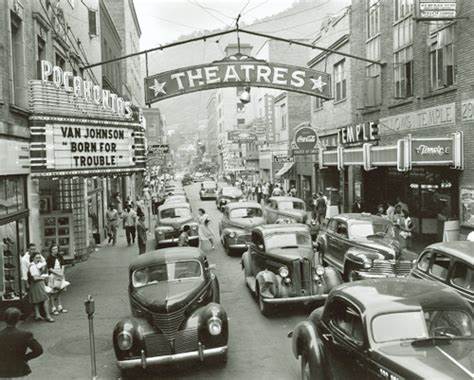Post war prosperity also led Americans to replace outdated home appliances, buy a new refrigerator, or a television set. "Come closer, sweetheart. Say, I don't think that's fair, because we can't get closer." "Oh, but you could, if you had one of the new Westinghouse television sets with the exclusive Electronic Magnifier that gives you a big close-up image whenever you want it. All you do is turn the Electronic Magnifier knob, and there -- you get the heart of the picture. And see? I'm close enough to say, ‘Hello, good looking!'" Actress Betty Furness was commercial spokeswoman for Westinghouse.
"And every Sunday night, General Electric brings you the finest motion picture stars on TV -- the great names in comedy ... mystery ... romance. Every week, a star, all summer long, on the General Electric Theater." Over at competitor General Electric, actor Ronald Reagan -- later the fortieth president of the United States -- and often referred to as the Great Communicator, was for many years an effective television commercial spokesman every week on the GE Theater. Parents also tried to improve their children's education. In nineteen sixty, parents bought almost three times as many educational books as they did ten years before. Parents also bought millions of dollars' worth of pianos, violins and other musical instruments for their children. It was true that the average number of children per family was increasing. But the total population of the United States did not increase as much during this period as one might have expected.

The reason for this was that fewer immigrants were coming to the United States. In fact, the number of immigrants had been dropping for many years. In nineteen ten, eleven immigrants were coming to America for every thousand Americans already living here. By nineteen fifty, less than two immigrants were coming for every thousand Americans. Where immigrants were coming from also changed. In the past, most came from northern and western Europe. But now, growing numbers of people came to the United States from southern and eastern Europe and from Latin America and Asia. Other changes in the United States population were also taking place. In the nineteen fifties, most Americans still lived in the eastern, central and southern parts of the country. But growing numbers moved west. The population of the western states increased by almost forty percent during the nineteen fifties.
Remember we said the United States population gets counted every ten years? One reason is because populations are used to decide how many members each state will have in the House of Representatives. Population changes can mean changes in the political influence of individual states in Congress. Another population change after World War Two was in life expectancy. An American born in the early nineteen hundreds could only expect to live about forty-seven years. By the nineteen fifties, however, most Americans could expect to live well past their sixtieth birthday. Life expectancy continued to increase with improvements in living conditions and medical care. The United States was a changing country, a nation on the move after World War Two. Next week on our program, we look at political events that shaped the post-war period.












